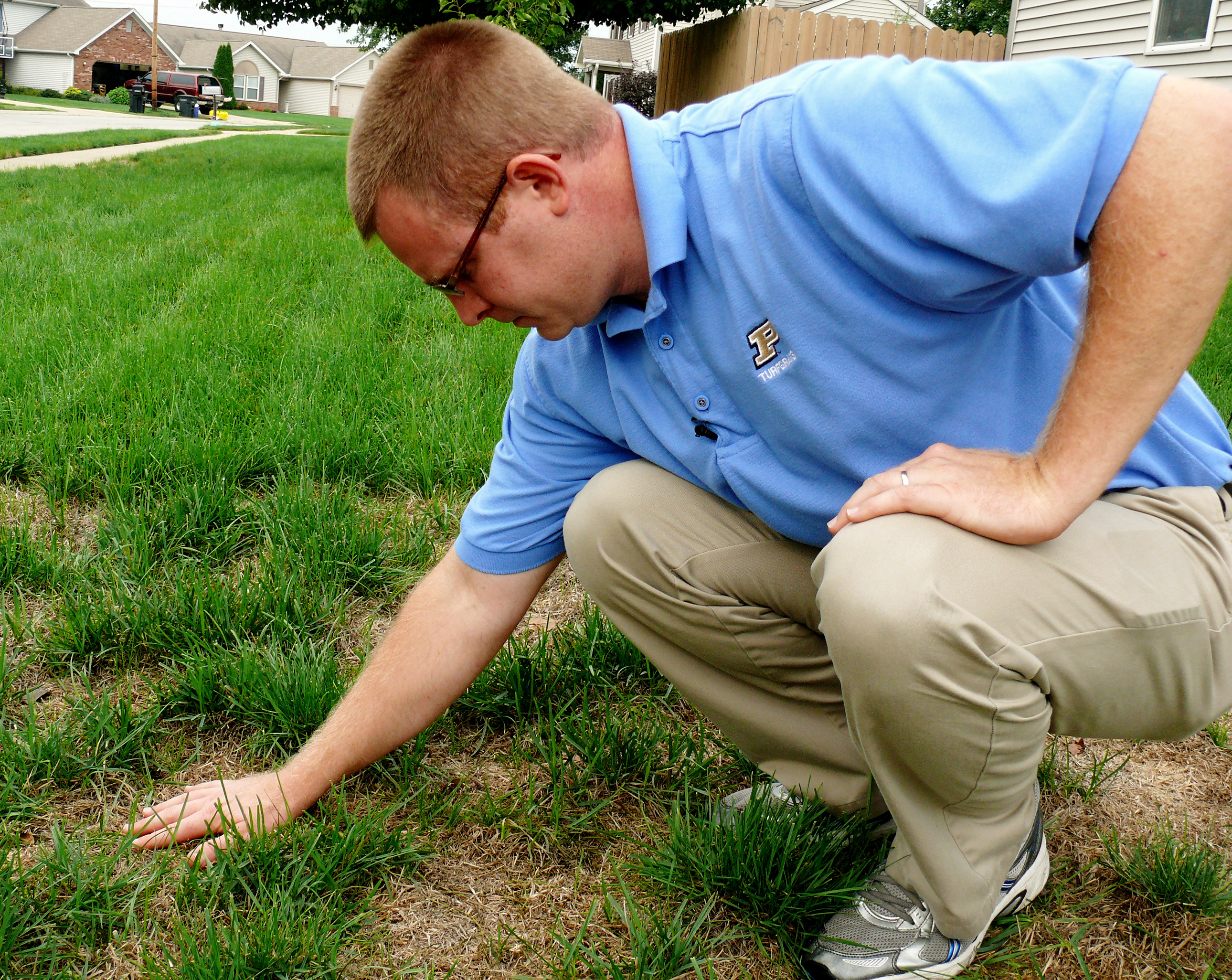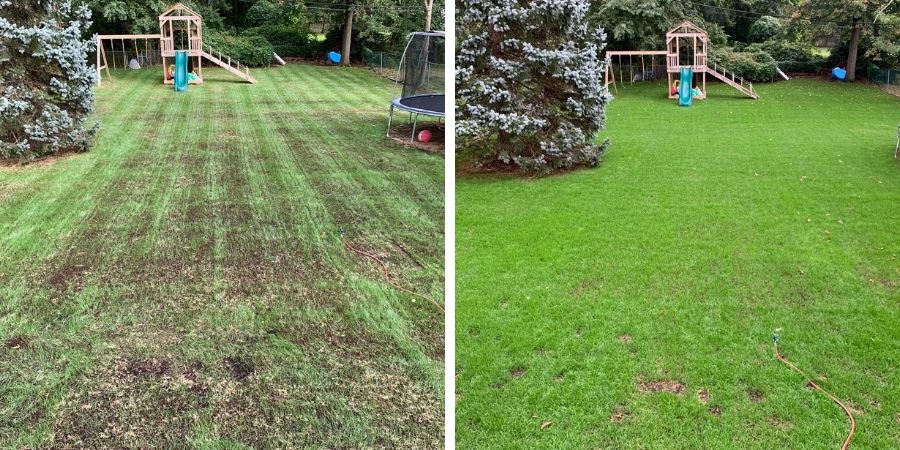To repair a drought-damaged lawn, water it deeply and consistently until the soil is moist, and then reseed any bare patches. Introducing moisture and providing new seeds will help restore the lawn’s health and promote lush green growth.
In addition, regularly mowing and fertilizing the lawn will further aid in the recovery process. Taking these steps will give your lawn the proper care it needs to overcome drought damage and regain its vitality.

Credit: www.purdue.edu
How to Repair Drought Damaged Lawn : Step by Step Guide
Assessing The Damage
Assessing the damage caused by drought is the first step towards repairing your lawn. Look for signs of drought stress such as wilting, discoloration, and thinning of grass. Assess the severity by checking the depth and extent of the dryness in the soil.
Different types of grass have varying tolerance to drought, so understanding the impact on your particular grass type is crucial. Determine if your lawn needs simple irrigation or more extensive care such as overseeding or fertilization. By paying attention to the signs of drought stress and assessing the damage accurately, you can take the necessary steps to repair your lawn and restore its health and beauty.
Immediate Recovery Strategies
Repairing a drought damaged lawn requires immediate action. One effective recovery strategy is employing proper watering techniques. Timing and frequency play a vital role in reviving dehydrated lawns. It is essential to water the affected area optimally for the best results.
Utilizing irrigation systems efficiently can ensure the distribution of water evenly. To achieve this, ensure proper calibration and maintenance of the system. Adjusting irrigation schedules based on the lawn’s needs is crucial. Avoid overwatering or underwatering, as both can hinder the recovery process.
Consistency is key in nurturing a drought-damaged lawn back to health. By implementing these watering techniques, you can effectively repair and restore your lawn after it has faced the consequences of a drought.
Restoring And Repairing The Lawn
Restoring and repairing your drought-damaged lawn requires removing dead or dying grass. Assess the extent of the damage, then decide between overseeding and reseeding. Overseeding involves spreading grass seed over existing turf, while reseeding requires starting from scratch. When choosing the right grass seed for re-establishment, consider factors like climate, shade tolerance, and soil conditions.
Opt for a seed blend that matches your region and offers durability. To begin the repair process, prepare the lawn by removing weeds and debris, then mow the existing grass to a short height. Loosen the soil with a rake and spread the chosen grass seed evenly.
Water the area regularly and keep foot traffic minimal until the new grass has had time to establish itself. With careful attention and consistent maintenance, your lawn will recover from drought damage and flourish once again.
Nurturing The Rejuvenated Lawn
To repair a drought damaged lawn, nurturing it is essential. Promoting growth can be achieved through effective fertilizing techniques. Additionally, proper mowing practices are crucial for the rejuvenation of the lawn. Regular maintenance scheduling plays a vital role in sustaining its health.
By following these guidelines, the damaged lawn can be restored to its former glory.
Preventing Future Drought Damage
Repairing a drought damaged lawn is crucial for maintaining a healthy and vibrant yard. To prevent future damage, it’s essential to implement effective watering practices that promote deep root growth. Choose drought-tolerant grass varieties that can endure water scarcity and still thrive.
Another useful method is applying soil amendments to improve water retention within the soil. These amendments help the ground retain moisture for longer periods, reducing watering frequency. By incorporating these strategies, you can ensure your lawn remains resilient and lush, even during drought conditions.
Keep in mind that maintaining a well-prepared and properly irrigated lawn is the key to preventing drought damage and enjoying a green and beautiful landscape.
Frequently Asked Questions On How To Repair Drought Damaged Lawn
Can Grass Come Back After A Drought?
Yes, grass can recover from drought conditions and regrow with proper care and irrigation.
What Do I Put On My Lawn During A Drought?
Water deeply and infrequently, use drought-tolerant grass, and apply mulch to retain moisture.
What Does Drought Stressed Grass Look Like?
Drought stressed grass appears brown, dry, and brittle due to lack of water.
How Do I Fix Bald Spots On My Lawn?
To fix bald spots on your lawn, follow these steps: 1. Identify the cause of the bald spots, such as compacted soil, pets, or lack of sunlight. 2. Rake and loosen the soil in the bald spots to create a better growing environment.
3. Apply grass seed or sod to the bare areas, making sure to choose the right type for your climate. 4. Water the newly seeded or sodded areas regularly and keep them well-maintained. 5. Monitor the progress and make adjustments as needed to promote healthy lawn growth.
Conclusion
Restoring a drought damaged lawn is not an impossible task. With proper care and attention, you can revive your lawn and bring it back to its lush green state. Start by assessing the extent of the damage and determining the best course of action.
Implement a regular watering schedule, deep watering techniques, and consider using a drought-tolerant grass variety. Don’t forget to mow your lawn at the recommended height and aerate it to improve air circulation and water absorption. Fertilize your lawn with an appropriate blend of nutrients to encourage healthy growth.
Lastly, be patient and consistent in your efforts, as it may take some time for your lawn to fully recover. By following these steps and adopting sustainable lawn care practices, you’ll be well on your way to a beautiful and drought-resistant lawn that can withstand the challenges of the future.
So, go ahead and give your lawn the TLC it deserves!

